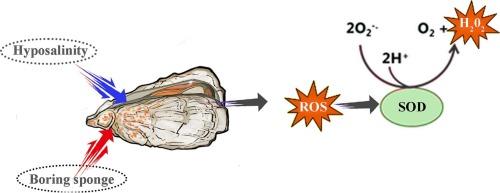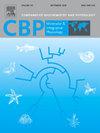短期低盐度胁迫对侵染钻孔海绵的太平洋牡蛎(Magallana gigas)的影响
IF 2.2
3区 生物学
Q4 BIOCHEMISTRY & MOLECULAR BIOLOGY
Comparative Biochemistry and Physiology A-Molecular & Integrative Physiology
Pub Date : 2025-08-21
DOI:10.1016/j.cbpa.2025.111925
引用次数: 0
摘要
本研究研究了16小时短期低盐度胁迫对感染了无聊海绵Pione vastifica (Hancock, 1849)的太平洋牡蛎Magallana gigas (Thunberg, 1793)血细胞功能状态的影响。我们还研究了M. gigas地幔中的促氧化-抗氧化状态、与氧化应激和热休克蛋白相关的基因表达、生长停滞和DNA损伤。我们的研究结果显示,在盐度为5 psu和10 psu的情况下,血细胞细胞内活性氧水平显著增加。盐度从18psu降低到10psu,导致双壳类地幔超氧化物歧化酶活性显著增加。然而,在低盐度环境下,血细胞线粒体膜电位、过氧化氢酶活性、硫代巴比妥酸活性物质水平、抗氧化酶基因表达和地幔热休克蛋白表达均未发生变化。在低盐度条件下,海绵侵染过程中促氧化-抗氧化平衡的变化表明了该软体动物氧化应激的发展。热休克蛋白在海绵侵染和低盐度胁迫条件下表达不高,具有保护双壳类动物免受渗透胁迫的作用。本文章由计算机程序翻译,如有差异,请以英文原文为准。

The impact of short-term hyposalinity stress on the Pacific oyster (Magallana gigas) infested with boring sponges (Pione vastifica)
This study investigates the effects of 16-h short-term hyposalinity stress on the functional state of hemocytes in the Pacific oyster Magallana gigas (Thunberg, 1793) infected with the boring sponge Pione vastifica (Hancock, 1849). We also studied pro-oxidant-antioxidant status, expression of genes associated with oxidative stress and heat shock proteins, growth arrest and DNA damage in the M. gigas mantle. Our results showed a significant increase of intracellular reactive oxygen species levels in hemocytes under exposure of salinity 5 psu and 10 psu. A decrease in salinity from 18 psu to 10 psu led to a significant increase in superoxide dismutase activity in bivalves mantle. However, no alterations in mitochondrial membrane potential in hemocytes, catalase activity, thiobarbituric acid reactive substance levels, gene expression of antioxidant enzymes, and heat shock protein expression in the mantle under low salinity exposure were observed. The changes in the prooxidant-antioxidant balance during sponge infestation under low salinity conditions indicate the development of oxidative stress in this mollusk. Heat shock proteins, which can protect bivalves against osmotic stress, did not show higher expression under sponge infestation and hyposalinity stress conditions.
求助全文
通过发布文献求助,成功后即可免费获取论文全文。
去求助
来源期刊
CiteScore
5.00
自引率
4.30%
发文量
155
审稿时长
3 months
期刊介绍:
Part A: Molecular & Integrative Physiology of Comparative Biochemistry and Physiology. This journal covers molecular, cellular, integrative, and ecological physiology. Topics include bioenergetics, circulation, development, excretion, ion regulation, endocrinology, neurobiology, nutrition, respiration, and thermal biology. Study on regulatory mechanisms at any level of organization such as signal transduction and cellular interaction and control of behavior are also published.

 求助内容:
求助内容: 应助结果提醒方式:
应助结果提醒方式:


